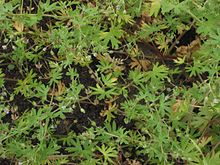Small cranesbill
| Small cranesbill | ||||||||||||
|---|---|---|---|---|---|---|---|---|---|---|---|---|

Little cranesbill ( Geranium pusillum ) |
||||||||||||
| Systematics | ||||||||||||
|
||||||||||||
| Scientific name | ||||||||||||
| Geranium pusillum | ||||||||||||
| L. |
The small cranesbill ( Geranium pusillum ) is a plant species that is also widespread in Central Europe and belongs to the cranesbill family (Geraniaceae).
description
The little cranesbill is an annual or biennial plant (summer or winter annual). It has a thin tap root that can reach a depth of 60 cm. It reaches heights of growth of 15 to 30 cm. The stems are prostrate or ascending and are 50 (rarely 70) cm long. They are heavily branched, protruding with short hairs, often balding, usually with glandular hairs on the upper side.
The leaves of the basal rosette are stalked 4 to 8 cm long. Their leaf blades are 1 to 3 cm wide, rounded in outline and 3/4 divided into five to seven (rarely nine) lobes. The stem leaves are opposite, near the flowers seemingly alternate. They are stalked 0.5 to 5 cm long. Their leaf blades are 2 to 3 (rarely 5) cm wide, softly hairy on both sides and 3/5 to 4/5 divided into five to seven lobes. The lobes themselves are (rarely two- to five-) mostly three-lobed. The stipules are small, pointed and ciliate.
The partial inflorescences are mostly two-flowered, mostly protrude over the bracts. They are stalked 3 to 10 mm, the lowest also up to 20 mm long. The flower stalks themselves are 6 to 12 mm long, spreading to down, then upright again when the fruit is ripe. The stem and the calyx have 0.1 to 0.2 mm long, protruding glandless and glandular hairs. The hermaphroditic, radial symmetry, five-fold flowers have a maximum diameter of 1 cm. The five hairy sepals are usually 2.5 to 5.5 mm (1 to 6 mm) long and short-pointed. In addition to their short hair, they also have silk hair 0.5 to 1 mm long. The five pale lilac petals are 2.5 to 4 mm long, about as long as the calyx. They are weakly edged and the nail is eyelashed. Three to five of the ten stamens are reduced to staminodes . The stamens are whitish and the anthers are purple. The scars are purple.
The fruit is hairy when pressed and 8 to 12 mm long. The fruit flaps are about 22 mm long, close fitting, but not hairy glandular. The fruit beak has downy hair and short glandular hairs. The seeds are smooth and light brown.
The number of chromosomes is 2n = 26, 34 or 36.
ecology
The flowering period extends from May to October. The flowers are slightly proterogynous . In addition to insect pollination , self- pollination is also common. As pollinators act syrphids , small Apoiden and grave wasps . The inflorescence is equipped with stalked glands, but this does not prevent small insects from creeping up.
The fruits are glandular when young, they act as desiccants and centrifugal fruits ; they reach a throwing distance of up to 1.90 m. The closely-fitting, hairy partial fruits eagerly absorb water and adhere very well to damp and wet vertebrates. This results in their spreading as watery and as soil creepers on alternating moist soils. In addition, there is a cultivation spread by birds and a chance spread by artifacts . The fruit ripens between June and October.
The little cranesbill has roots up to 60 centimeters deep.
Occurrence
The lesser cranesbill occurs from North Africa across Europe to West Asia (Afghanistan, Kashmir, Russia) and has a meridional to temperate, more oceanic distribution.
It grows on roadsides, village squares and vineyards in nutrient-rich, mostly lime-poor, often sandy to loamy soils. It is a definite nitrogen pointer. It occurs from the colline to the montane (rarely subalpine) altitude . In Central Europe it is a character plant of the class Chenopodietea.
swell
literature
- Xu Langran, Carlos Aedo: Geranium. In: Wu Zheng-yi, Peter H. Raven, Deyuan Hong (Eds.): Flora of China . Volume 11: Oxalidaceae through Aceraceae . Science Press / Missouri Botanical Garden Press, Beijing / St. Louis 2008, ISBN 978-1-930723-73-3 , pp. 13 (English, online ).
- Rudolf Schubert , Klaus Werner, Hermann Meusel (eds.): Excursion flora for the areas of the GDR and the FRG . Founded by Werner Rothmaler. 13th edition. tape 2 : vascular plants . People and knowledge, Berlin 1987, ISBN 3-06-012539-2 (area).
- Siegmund Seybold (Ed.): Schmeil-Fitschen interactive . CD-ROM, version 1.1. Quelle & Meyer, Wiebelsheim 2002, ISBN 3-494-01327-6 .
Individual evidence
- ↑ a b c Erich Oberdorfer : Plant-sociological excursion flora for Germany and neighboring areas . With the collaboration of Angelika Schwabe and Theo Müller. 8th, heavily revised and expanded edition. Eugen Ulmer, Stuttgart (Hohenheim) 2001, ISBN 3-8001-3131-5 , pp. 627 .
- ↑ a b Ruprecht Düll , Herfried Kutzelnigg : Pocket dictionary of the plants of Germany and neighboring countries. The most common Central European species in portrait . 7th, corrected and enlarged edition. Quelle & Meyer, Wiebelsheim 2011, ISBN 978-3-494-01424-1 .
Web links
- Small cranesbill. In: FloraWeb.de.
- Profile and distribution map for Bavaria . In: Botanical Information Hub of Bavaria .
- Geranium pusillum L. In: Info Flora , the national data and information center for Swiss flora .
- Distribution in the northern hemisphere from: Eric Hultén, Magnus Fries: Atlas of North European vascular plants. 1986, ISBN 3-87429-263-0 at Den virtuella floran. (swed.)
- Thomas Meyer: Data sheet with identification key and photos at Flora-de: Flora von Deutschland (old name of the website: Flowers in Swabia )
- photos





